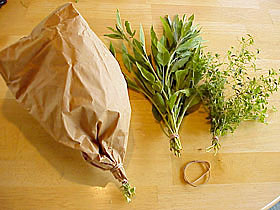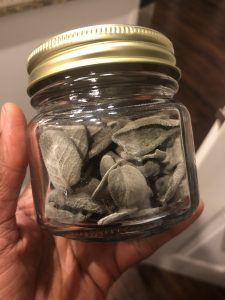Whether you want dried herbs for cooking, rituals, or decorating your home, a few simple steps will make this process easy and efficient. There are two options in this post: drying with a dehydrator and without one.
How to Gather Your Herbs
You can harvest and dry herbs throughout the year but they are ideal for drying just before they blossom, just as the buds appear plump. Harvest during the late morning once the dew has dried but the intense sunlight has not caused leaves to wilt.
If you plan to dry the herbs in a dehydrator, you can clip them from the stem (or in some cases, select individual leaves). If you plan to dry the herbs without a dehydrator, it is essential to clip from the stem. In both cases, remove any damaged leaves.
Rinse your herbs with cool water. Allow them to air dry on a towel. I don’t recommend hand drying them because that may bruise leaves.
How to Dry Herbs Using a Dehydrator
Once dry, place your herbs on the drying racks in a single layer. Minimize clumping and overlap to promote even drying. (Layered herbs looked better in the picture, but I didn’t dry them this way!)
If you are using a box dehydrator, insert the racks. Then set the heat on the lowest setting. I recommend checking the racks every hour. You will know that the herb is dry when the stem snaps easily and the leaves effortlessly detach from the stem.
If you are using a stackable dehydrator, you will still want to dry the herbs on the lowest setting. The important thing is to rotate your stacks occasionally (every hour, if possible) so that they dry evenly. If you’re unable to do this, place the moistest and/or thickest herbs at the bottom of the stack, closest to the heat source.
As you rotate the stacks, check the herbs. Some will dry faster than others. You will know that the herb is dry when the stem snaps easily and the leaves effortlessly detach from the stem.
Drying without a Dehydrator
Before dehydrators, herbalists and gardeners let nature do the work. For this method, you will need your herbs, small paper bags, scissors, and twine. When you aren’t using a dehydrator, you can still successfully dry herbs. It will simply take a bit more attentiveness and time.
When harvesting your herbs, clip at the stems (about 1/2″ from the base for most plants). After washing and air drying, bind the stems with twine. Leave a long segment of twine attached to the spool.
 It is optional to punch holes in your paper bags using scissors. I recommend it for air circulation.
It is optional to punch holes in your paper bags using scissors. I recommend it for air circulation.
With or without the holes, insert the bundle of herbs with the stems sticking out of the bag. Use the excess twine to tie the bag closed around the stems. Create a knot to keep the bag closed around the stems. Then use the rest of the twine to suspend the herbs upside down in a dry, sunny spot.
You will want to occasionally check the bag to make sure it (and the herbs) are free of mold, mildew and bugs.
Drying times vary based on the herb and its drying conditions. You will know that the herb is dry when the stem snaps easily and the leaves effortlessly detach from the stem.
How to Store Dried Herbs
Once your herbs are dry, remove the leaves from the stems. Store dried herbs in air-tight containers. I prefer glass, as plastic seems to absorb oils and aromas. Many plastics may also leach into your food, so I avoid plastic as much as possible.
You’ll want to find a cool, dry place to store your herbs. Most herbs can handle clear glass jars if you keep them in a pantry or cabinet, for example. If you store your herbs in an open space, use storage containers that minimize sunlight exposure. Sunlight will cause your herb to deteriorate faster.
Enjoy your herbs within 6 months! If you’ve got tons that you can’t use that quickly, you may be able to extend its shelf life: put your herbs in Miron glass / biophotonic glass to seal out air and UV rays. You can also store your herbs in an airtight container and put that in a sealable bag for double protection. Store it in a cool, dark place.
What are your favorite herbs to dry? Any additional tips that you’d like to share with the community?